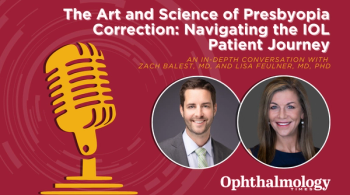
Epidemiologic results raise need for better diagnosis, management of XFS
Exfoliation syndrome (XFS) is a global disease that is important to recognize because of its association with other visual-threatening ocular pathologies, said Alan H. Robin, MD, of the Wilmer Eye Institute at Johns Hopkins University in the United States.
Exfoliation syndrome (XFS) is a global disease that is important to recognize because of its association with other visual-threatening ocular pathologies, said Alan H. Robin, MD, of the Wilmer Eye Institute at Johns Hopkins University in the United States.
Speaking at the World Ophthalmology Congress, Dr. Robin presented his data from an epidemiological study of XFS conducted in southern India that illustrated XFS was a risk factor for glaucoma and highly associated with cataract as well as with vision impairment and blindness from those latter disorders. In that study, about 5,500 subjects underwent a thorough eye examination by ophthalmologists who were carefully trained to identify XFS. A diagnosis of XFS was made in about 6% of the population, and among those individuals, about two-thirds had bilateral disease.
In a multivariate adjusted analysis, XFS increased the risk of glaucoma about sixth-fold. In addition, the study found almost 97% of phakic eyes with XFS had an opacified lens, while 132 eyes had prior cataract surgery. The diagnoses of lens opacification and glaucoma were associated with significant vision loss. Presenting vision was impaired (20/60 or worse) in 91% of eyes with XFS, and 51% were bilaterally blind. After best correction, 60% of eyes with XFS had impaired vision and 26% were bilaterally blind. About 90% of the cases of blindness were accounted for by cataract and 10% by glaucoma, and 60% of patients presenting with glaucoma were blind in both eyes.
"Due to the prevalence of glaucoma and cataract among patients with XFS, we have to be much more careful in identifying individuals with this disease. Leaders in this field need to do better in teaching our residents and colleagues in the community that XFS is found in populations worldwide, that patients with XFS and glaucoma need aggressive care and follow-up, and about methods for improving the outcomes of cataract surgery in these eyes so that we do not create even more blindness," said Dr. Robin.
Newsletter
Don’t miss out—get Ophthalmology Times updates on the latest clinical advancements and expert interviews, straight to your inbox.


















































.png)


